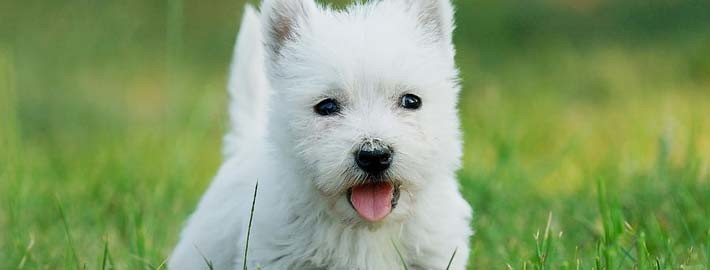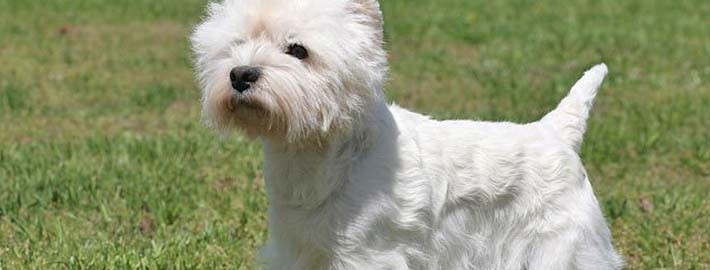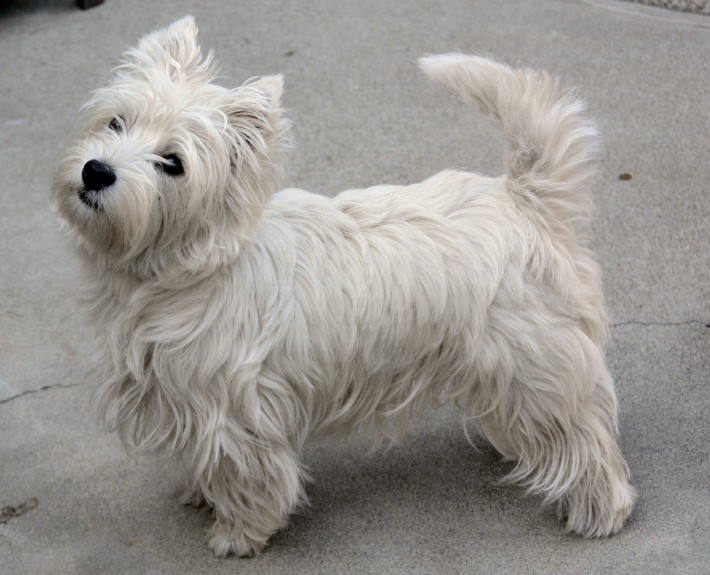What makes the West Highland White Terrier Unique?
The hardy West Highland White Terrier, more commonly known as the “Westie,” is known for its friendly, strong-willed personality and a remarkably bright white coat. Said to be “all terrier,” this breed possesses a large amount of spunk, determination and devotion stuffed into a compact little body. The confident Westie excels in a variety of AKC events, from conformation to agility to obedience.
Breed Groups
Page Contents

Is the West Highland White Terrier Right For You?
The Westie loves people and makes an affectionate addition to any family. This devoted, happy and faithful dog also makes a wonderful travel companion due to its small size. Their dry coats are a combination of a soft dense undercoat and a rough outer coat. Daily brushing and regular clipping or stripping of the coat is necessary.
In 5 Words
- Alert
- Docile
- Friendly
- Responsive
- Gorgeous
Characteristics
Learn About the West Highland White Terrier
Description
The West Highland White Terrier, often simply called the Westie, is a small, sturdy dog. The head is in proportion to the body and when viewed from the front gives off a round appearance. The blunt muzzle is slightly shorter than the skull and tapers toward the nose. There is a defined stop. The nose is black. The teeth meet in a scissors bite with teeth that are large in proportion to the dog. The almond-shaped, deep-set, dark brown eyes are set wide apart. The ears are erect, set wide apart on top of the head and triangular in shape, coming to a point. The legs are somewhat short but not too low to the ground. The undocked tail is relatively short, about 5-6 inches (12.5-15 cm) long, thicker at the base and tapering to a point. Dewclaws are sometimes removed. The double coat has a straight, hard outer coat that is about 2 inches long (5 cm) and a soft, dense undercoat. The coat color is solid white.
Short History of the West Highland White Terrier
The Westie is grouped with and probably closely related to the other terriers of Scotland, including the Cairn, the Dandie Dinmont, the Scottish and the Skye. It was bred to be a working terrier, going to ground to combat rats, rabbit, badger and fox. Legend has it that Colonel Malcolm was hunting with his small brown terriers and accidentally shot his favorite, mistaking it for a fox. Malcolm apparently set about developing a small white dog that could perform all the functions of a working terrier but would never be accidentally mistaken for prey. He selected the lightest puppies from litters of Cairn Terriers and bred them without crossing with any traditionally tan dogs. Eventually, he created pure white terriers that bred true to type, temperament, function and color.
Temperament
The West Highland White Terrier is a game and hardy little terrier that is easy to train. It is fairly friendly toward strangers and gets along well with children. Easy dog to travel with. These dogs are lively and extremely self-assured toward other dogs, but will not pick fights if their owners know how to display proper leadership. They may chase a cat for fun, and need to be corrected if they do attempt this. Robust, friendly and spirited, Westies just love companionship. Despite their size, they make a very good watchdog. The Westie likes to dig and bark. If a Westie is allowed to become the pack leader, it may snap when irritated and be combative with other dogs. A lack of leadership on the owner’s part can cause many behavior problems, such as biting, guarding food and furniture. A Westie that has an owner who knows how to display firm, confident, consistent, leadership will not experience these behavioral problems. These problems can be corrected once the owner becomes the dog’s true pack leader. Do not allow the Westie to develop Small Dog Syndrome.
Caring for Your West Highland White Terrier
General Health
The average life span of the West Highland White Terrier is 12 to 14 years. Breed health concerns may include copper toxicosis, globoid cell leukodystrophy, Legg-Calve-Perthes disease, pulmonary fibrosis, pulmonic stenosis, generalized demodicosis, hepatitis, pyruvate kinase deficiency, congenital deafness, keratoconjunctivitis sicca (dry eye), corneal ulceration, cataracts, ectopic ureters, epidermal dysplasia (Armadillo Westie syndrome; Malassezia dermatitis) and white shaker dog syndrome.
Grooming & Bathing
The harsh, straight, shorthaired double coat is fairly easy to groom and sheds little to no hair. Simply brush regularly with a stiff bristle brush. Brushing should keep the coat clean, so bathe only when necessary. Trim around the ears and eyes with blunt-nosed scissors. The whole coat should be trimmed about every four months and stripped twice a year.
Exercise & Training
These little dogs need a daily walk. Play will take care of a lot of their exercise needs, however, as with all breeds, play will not fulfill their primal instinct to walk. Dogs that do not get to go on daily walks are more likely to display behavior problems. They will also enjoy a good romp in a safe, open area off lead, such as a large, fenced-in yard.











